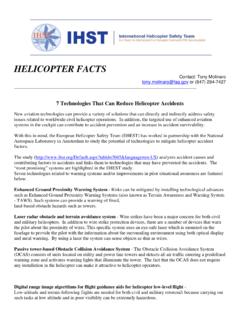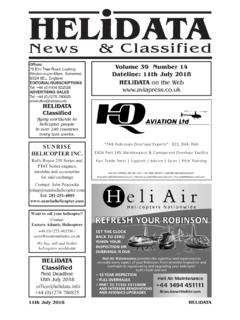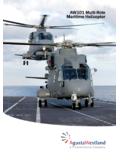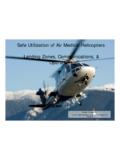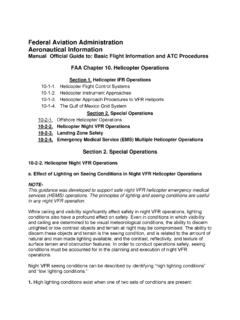Transcription of Presentation IHST-CIS 2016
1 helicopter ACCIDENTS: Statistics, Trends and CausesPrepared by helicopter Safety Analysis Team of IHSTI-CISIHST Regional Partners PanelMarch 2, 2016 , Louisville, Kentucky, USA Commercial air travel and aerial work141021161391011912116691075452552127 3053382162328382701020304050602005200620 0720082009201020112012201320142015 Registered Accidents and Fatal AccidentsAccidentsFatal AccidentsFatalitiesAccidents 136 Fatal Rate per 100,000 hoursAccidentsFatal AccidentsReduction of accidents by 9,5%Reduction of fatal accidents by 24%Commercial air travel and aerial of Accidents by ActivityTrainingPositioning/ferryAir travelAgricultural workPassenger/Cargo (aerial work)External loadAerial observationAir tour/sightseeingEmergency medical servicesUtilities patrolSARO therCommercial air travel and aerial workErrors38%Violations33%System failure22%Other7%Percentage of Accidents by Immediate CauseCommercial air travel and aerial of Accidents by ErrorMisassessment of weatherMisjudgment of landing ariaNot going aroundFlight below minimum safe altitudeOverloadNot considering windInadequate pilot judgmentPoor circumspectionCommercial air travel and aerial workViolation of minimum safe altitude55%Violation of weather minima30%Other15%Percentage of Accidents by ViolationCommercial air travel and aerial of Accidents by System FailureEngine failureMain gear box fireTail rotor blade breakageDirectional control failurePitch control failureTail boom breakageTail rotor pylon breakageTrimming
2 FailureCommercial air travel and aerial work Absence of effective SMS Superficial approach to selection of flight personnel for commissioning as PIC Deficiencies in training and not transfer of skills, professional care and the ability to make decisions Shortcomings in interaction between simulator training centers and flight management of helicopter companies Insufficient experience of instructors Lack of attention to the training in decision-making for departure with taking into account the possible complications of flight conditions Low requirements of PIC to crew members, failure to keeping work technique Inadequate use of FDR/CVR data for flight quality control Weak safety cultureCAUSES OF ERRORS AND VIOLATIONSC ommercial air travel and aerial workGeneral aviation71191113454664981317024681012141 6182020112012201320142015 Registered Accidents and Fatal AccidentsAccidentsFatal accidentsFatalitiesAccidents57 Fatal accidents 25 Fatalities51 Note.
3 Due to lack of accurate flight hour information, it is not possible to estimate accident rate per 100,000 hours with acceptable confidence of Accidents by Immediate CauseWrong pilot's techniqueViolationsSpatial disorientationSystem failure due tofaulty designFor these reasons, there were approximately 24% of accidents of CFIT category, 17% due to inadvertent flight from VFR to IMC, 6% due to collision with power lines, 20% due to system component failures, initiated by flight or technical have been some accidents resulted from deliberate violations of flight rules by pilots such as maneuvering at extremely low altitudes and transfer of the aircraft controls to outsiders. General aviation Imperfection of legislation regulating the GA activities Lack of supervision over GA operators Failure to identify and illuminate the causes of accidents Poor quality of pilot training Imperfect aircraft certification system Lack of control for maintaining the aircraft airworthiness Inadequate safety ensuring at landing sites Inadequate meteorological support Insufficient experience of training personnel Low effectiveness of search and rescue system Pathological safety cultureSYSTEMIC DEFICIENCIES ADVERSELY AFFECTING SAFETY.
4 General aviationLight helicopters76101128610101211334321353635 811762310615802468101214162005 2006 2007 2008 2009 2010 2011 2012 2013 2014 2015 Registered Accidents and Fatal AccidentsAccidentsFatal accidentsFatalitiesNote:- Not all accidents are registered- Commercial and non-commercial flights are not separated - Light helicopters are mainly operated in GA sector and by private ownersAccidents 93 Fatal *Accident rate per registered aircraft Accident/FleetFatal accident/FleetReduction of accidents by 30%Reduction of fatal accidents by 44%Light helicoptersFleet losses(2006 -2014г)Manufacturer Civil aircraft registerDestroyedRobinson 44335 (1:13)Eurocopter1518 (1:19)Bell Helicopter403 (1:13)Aerospatiale262 (1:13)AgustaWestland162(1:8)MD Helicopters60 Aerocopter50 Schweizer51 Other190 Total:71150 (1.)
5 14)Light of Accidents by Immediate CauseVFR flight in IMCLost of control in VMCCFIT (power lines orterrain/water)Running out of fuelMidair collisionIn of fatal accidents pilots were under the influence of alcoholLight helicoptersEvery second accident occurred in VFR flight in instrument meteorological conditions! All on helicopters not certified for IFR:R-44 (11), R-66 (1), Bell-407 (2), AS-350/355 (3), AW-119 (1), MD-600 (1), EC-120 (1) Causes: return home syndrome pressure on pilot by customer the complexity of instrument piloting erroneous transfer of experience gained on Russian made helicopters disorientation in reduced visibility (night, featureless terrain, soft background) inability to recognize entering into instrument MC whiteout snow whirlwind at takeoffEvery third accident occurred due to the loss of control in visual meteorological conditions!
6 Causes: aggressive maneuvering main rotor speed decayLight helicoptersCONCLUSIONoIn the commercial sector, safety performance for the period of 2005 -2015 experienced a gradual improvement, but it was GA and aircraft owner sectors, where light helicopters are the most widely used, registered accident number for the 2005-2015 period has been showing an upward trend and tend to increase. Number of accidents per registered aircraft for the period from 2009 to 2015 had been decreasing and tend to current state of safety does not satisfy the professional community and the public both in Russia and in other CIS countries. oThe causes of the accidents with helicopters that took place in Russia and the CIS in the 2005-2015 period, are basically the same as the causes identified by JHSAT and for accident and fatal accident prevention developed by JHSAT and EHEST, contained in their records, are universal and basically coincide with the recommendations proposed by the analytical group of the absence of reliable data on flight hours in GA and aircraft owner sectors, we suggest to calculate helicopter accident rate per number of registered aircraft and to use this rate as an additional criterion for assessing safety performance trend in these sectors.
7 At the same time, we believe that it is possible and appropriate to make the necessary changes to aviation rules, establishing airworthiness procedures, that would allow to collect and process information ensuring calculation of accidents per 100,000 flight connection with systemic differences in the organization of commercial aviation, GA and aircraft owner sectors, the root causes of accidents and fatal accidents in these sectors also differ, even in respect of the same types of helicopters. In this regard, we believe that it is appropriate to specifically focus preventive work in each of the sectors in accordance with their characteristics. For example, in Russia these sectors could be specified according to the requirements in respect of certain categories of operators: FAR-246 for commercial air transport, the FAR -249 for aerial work, FAR 147 for general aviation, chapters 1 and 3 of FAR-128 for operators of light and ultralight THANK YOU FOR YOUR ATTENTION
